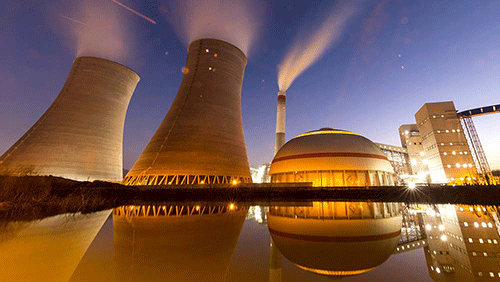Dr Nortin Titus
Egypt is the only country in Africa constructing a nuclear power reactor today. In the 11 years after the Fukushima Diiachi nuclear power plant accident, 75 nuclear power reactors were constructed and connected to the grid. Today, there are 56 nuclear power plants under construction that will add more than 57 GW of power to global electricity supply.
Designed to last more than 60 years, a nuclear power plant will produce more than 400 TWh of electricity in its planned lifetime. Costing about N$95 billion, the power plant will generate over N$360 billion in electricity sales over its lifetime if it sells its generated electricity from day one at 90c/kWh. These “back of the envelope” calculations project how profitable nuclear power plants are, and why they are being built all over the world.
In Namibia, the demand for uranium increased, and going by the export figures published, has gone from approximately
2 000 tonnes of yellow-cake exported in the 1990s after Namibia’s independence to well over 6 000 tonnes in the last few years. That’s a three-fold increase. Namibia has no plans yet to construct a nuclear power plant, although it has a nuclear fuel cycle policy that considers nuclear energy as part of its future energy mix. The “future” may just have passed already.
While Africa is focusing on “a just transition” and including climate resilience into economic growth paths, the rest of the world is scrambling to secure energy resources such as oil, gas, coal and uranium. The reason is that the physics has not changed when transforming energy sources (oil, gas, coal and uranium) to on-demand electricity at the terrawatt-hour (TWh) scale. A terrawatt-hour (1 TWh) provides electricity for 100 000 households in advanced economies,
whereas in low-income countries, a terawatt-hour of electricity supports over 1,000,000 households.
According to the IEA’s Africa Energy Outlook 2022 report, 400 million urban and rural households will gain electricity access by 2030, driving up electricity demand to 500 TWh. This demand can be easily covered by 40 nuclear power plants the size of Koeberg. If we assume that each plant is N$100 billion, such a roll-out of nuclear power plants across Africa could cost N$4 trillion ( US$ 220 billion).
Before we drop our jaws at the US$220 billion price tag, the total capital expenditure on solar PV and Wind power plants in 2017 was US$250 billion, in 2018- US$250 billion, in 2019 – US$250 billion, 2020 – US$200 billion, and in 2021 over US$300 billion. In five years, more than US$1.2 trillion.
Clearly, financing is not the problem.
Energy provision through nuclear power is on a sharp increase worldwide, and Asia has gotten the jump on the rest of the world. This is by and large what happened during the 50s and 60s in Europe in the post-WWII economic recovery, primarily driven by oil. Following the oil embargo in the 70s, the western world turned to nuclear power with an enormous ramp-up of nuclear builds during the latter part of the 70s and early 80s, reaching its height in 1985 with 37 reactors brought online in one year. In the 10 years after the oil embargo, 160 nuclear reactors were brought online. We could be seeing the same response as a result of the Ukraine-Russian war.
Clearly, the time it takes to building nuclear reactors is also not a problem as 160 reactors were built between 1975 and 1985, and similarly 75 reactors between 2011 and 2021.
And why nuclear power: because it provides baseload power. Baseload electricity is what you will need if you run an economic activity 24-hours a day throughout the year. Whenever you flip a switch, receive a WhatsApp message or respond to an email at 11pm or 2am, consider what is powering the technology infrastructure to be able to do such activity. And this is what Asia is preparing for and building up the reliable and stable electricity supply, relying less on coal and leaning towards nuclear energy.
Sadly, Africa is the only continent not embracing the technology fast enough. Furthermore, it is increasingly reliant on promises made towards “climate resilience” financing in the hope that richer nations will provide the financing for massive renewable energy infrastructure. However, the ever-increasing discoveries of oil and gas on the African continent and off-shore is starting to make African leaders question their strategy to base their future economic growth on primarily renewable energy technologies. Gas is becoming, with good reason, the flexy fuel. Supported by nuclear power as baseload, Africa has the basic energy resources to support double-digit economic growth and, more importantly, sustain it too. No nation has been able to escape the clutches of poverty without an oversupply of energy.
In the next decade, Africa stands the risk of being outcompeted by East Asia in attracting investment for manufacturing, the production of goods, raw material processing and value addition.
They will be able to do it faster and
cheaper because they made the critical investment into reliable electricity supply today, and not in the future.
The competition is stiff, the competitors fierce, and the pace at which Africa is responding to this competition for attention and financial resources does not match the ambition it has for its own future. Africa’s future commands high respect. Africa
must wake up and wake up quickly; there is a lot of work to do.
*Dr Nortin Titus (PhD, Stell.) is a nuclear physicist and the Chief Scientist at the Ministry of Mines & Energy. The views expressed in this article are entirely his own, and do not reflect those of his employer or any of his affiliates.


